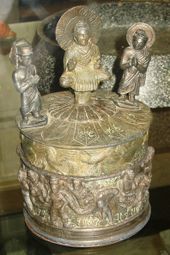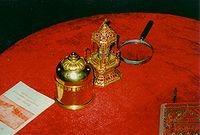
Kanishka stupa
Encyclopedia



Stupa
A stupa is a mound-like structure containing Buddhist relics, typically the remains of Buddha, used by Buddhists as a place of worship....
established by the Kushan king Kanishka
Kanishka
Kanishka ) was an emperor of the Kushan Empire, ruling an empire extending from Bactria to large parts of northern India in the 2nd century of the common era, and famous for his military, political, and spiritual achievements...
during the 2nd century CE in today's Shah-ji-Dheri on the outskirts of Peshawar
Peshawar
Peshawar is the capital of Khyber-Pakhtunkhwa and the administrative center and central economic hub for the Federally Administered Tribal Areas of Pakistan....
, Pakistan
Pakistan
Pakistan , officially the Islamic Republic of Pakistan is a sovereign state in South Asia. It has a coastline along the Arabian Sea and the Gulf of Oman in the south and is bordered by Afghanistan and Iran in the west, India in the east and China in the far northeast. In the north, Tajikistan...
.
The stupa was described by Chinese pilgrims in the 7th century as the tallest stupa in all India. Archaeologists have examined the remains of the structure and determined that it had a diameter of 286 feet. Ancient Chinese manuscripts tell of Buddhist pilgrims reporting that the stupa had a height of 591–689 feet (The measurements they stated were in Chinese units, which were 600–700. This height was equal to about 180–210 meters or 591–689 feet.
Three Chinese reports are known (by Faxian
Faxian
Faxian was a Chinese Buddhist monk who traveled to India, Sri Lanka and Kapilavastu in today's Nepal between 399 and 412 to acquire Buddhist scriptures...
, who travelled between 399–412 CE, Sung Yun who arrived in India in 518 CE, Xuanzang
Xuanzang
Xuanzang was a famous Chinese Buddhist monk, scholar, traveler, and translator who described the interaction between China and India in the early Tang period...
who went to India in 630 CE). Sung Yun describes the stupa in the following terms:
- "The king proceeded to widen the foundation of the Great Tower 300 paces and more. To crown all, he placed a roof-pole upright and even. Throughout the building he used ornamental wood, he constructed stairs to lead to the top....there was an iron-pillar, 3-feet high with thirteen gilded circlets. Altogether the height from the ground was 700 feet.”
The stupa was discovered and excavated in 1908–1909 by a British archælogical mission, and led to the discovery in its base of the Kanishka casket
Kanishka casket
The Kanishka casket or "Kanishka reliquary", is a Buddhist reliquary made in gilted copper, and dated to the first year of the reign of the Kushan emperor Kanishka, in 127 CE.-History and description:...
, a six-sided rock crystal reliquary
Reliquary
A reliquary is a container for relics. These may be the physical remains of saints, such as bones, pieces of clothing, or some object associated with saints or other religious figures...
containing three small fragments of bone, relics of the Buddha (which were transferred to Mandalay
Mandalay
Mandalay is the second-largest city and the last royal capital of Burma. Located north of Yangon on the east bank of the Irrawaddy River, the city has a population of one million, and is the capital of Mandalay Region ....
, Burma for safekeeping, where they still remain), and a dedication in Kharoshthi involving Kanishka.
According to Buddhist the building of the stupa was foretold by the Buddha:
- "The Buddha, pointing to a small boy making a mud tope….[said] that on that spot Kanishka would erect a tope by his name." Vinaya sutra
The same story is repeated in a Khotan
Khotan
Hotan , or Hetian , also spelled Khotan, is the seat of the Hotan Prefecture in Xinjiang, China. It was previously known in Chinese as 于窴/於窴 and to 19th-century European explorers as Ilchi....
ese scroll found at Dunhuang
Dunhuang
Dunhuang is a city in northwestern Gansu province, Western China. It was a major stop on the ancient Silk Road. It was also known at times as Shāzhōu , or 'City of Sands', a name still used today...
, which first described how Kanishka would arrive 400 years after the death of the Buddha. The account also describes how Kanishka came to raise his stupa:
- "A desire thus arose in [Kanishka to build a vast stupa]….at that time the four world-regents learnt the mind of the king. So for his sake they took the form of young boys….[and] began a stupa of mud....the boys said to [Kanishka] ‘We are making the Kanishka-stupa.’….At that time the boys changed their form....[and] said to him, ‘Great king, by you according to the Buddha’s prophecy is a Sangharama to be built wholly (?) with a large stupa and hither relics must be invited which the meritorious good beings...will bring."
Further reading
- D’Ancona, Mirella Levi. (1949): "Is the Kaniṣka Reliquary a work from Mathurā?" Art Bulletin, Vol. 31, No. 4 (Dec., 1949), pp. 321–323.
- Dobbins, K. Walton. (1971): The Stūpa and Vihāra of Kanishka I. The Asiatic Society of Bengal Monograph Series, Vol. XVIII. Calcutta.
- Dobbins, K. Walton (1968): "Two Gandhāran Reliquaries." East and West, 18, 1968, pp. 151–165.
- Hargreaves, H. (1910-11): "Excavations at Shāh-jī-kī Ḍhērī." Archaeological Survey of India, pp. 25–32.
- Spooner, D. B. (1908-9): "Excavations at Shāh-ji-Dherī." Archaeological Survey of India, pp. 38–59.

